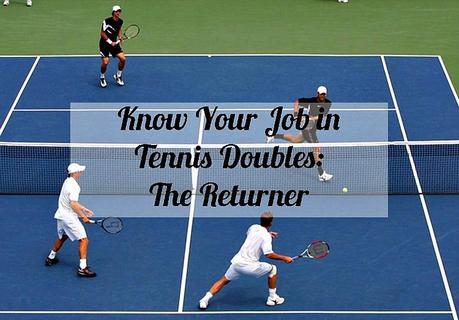Podcast: Play in new window | Download
This is the third installment in our mini series of podcasts called “Know Your Job in Tennis Doubles.” In this series, I’m giving you some quick and easy tips to tell you what you should be doing when you’re on court in a doubles match, no matter what position you’re playing. In third podcast in the series, we’ll talk about your job when you’re facing the serve and you don’t have control of that first shot – that’s right, we’re discussing the job of the returner.

You can listen to this episode by clicking on the gray media player above. You can read the edited transcript below for more information and to take notes:
TRANSCRIPT:
So let’s talk about the specifics of the returner’s job. What do you need to do as the returner?
1. Put the return in play at all costs. This is the most important part of your job. You cannot give away free points to your opponent by hitting your returns out. This may mean that your return is a simple block back cross court. But make sure you get that return over the net and in so that you force your opponents to hit one more shot.
2. Return from the best possible position. I bet you’ve seen this – the returner who stands way over to one side of the service box, trying to avoid hitting a return with his or her backhand. Do not be that returner! While you may not like your backhand return, you are not making your job any easier by taking an extreme position for your return. What you really need to do is position yourself so that your returns are more difficult for your opponents to deal with, not easier on you. Most likely, this means taking a number of different positions on your return rather than the same one over and over. So look over to where the server is standing and, at least initially, position yourself in the middle of all of the possible angles he or she might hit with the serve. As your match progresses, think about the types of serves you’re getting and take a position that will help you deal with those. Move in if the serves are shorter. Back up a step or two for deep, flat serves. Also, try taking different positions for your return. This can help you get into the head of the server and may invite some serves that actually play to your strengths rather than your weaknesses.
3. Attack weak serves with your body, not by hitting harder. Do not be lured into the mistake that I myself often make of getting greedy with a weak serve and trying to kill it. This usually just results in your return going out. Instead, take advantage of those weak serves by using your return to either hit a down the line return or a sharp angle return that can draw your opponent off court. Even if your return is not a winner, it can set up your next shot which could be.
4. Get into the net. We discussed this before in Episode 19 when we talked about the server’s job and I’ll link to that episode in the show notes. Bottom line – you know that, in doubles, the strongest formation you can take is usually with both partners playing up at the net. So use your return as a set up to help you get into the net. This means returns that you may consider “weaker,” like lob returns or slice returns, can actually be great because they give you time to come in and set you and your partner up to volley for the winner.
5. Use your return to set up your partner rather than to win the point. Remember – you’re playing doubles. So make sure you and your partner are working together to win the point. Hitting a sharp angle return that draws your opponent off court, for example, can set your partner up to volley into the open court for the winner. Letting your partner know that you plan to hit the next wide serve down the line helps your partner prepare for the possibility that, if that return isn’t as good as you’d hoped, the next ball may be directed at him or her. I can’t say it enough – in doubles, you need to communicate, communicate, communicate. So just do it.
And that’s the job description for the returner. In the next episode of Tennis Quick Tips, we’ll talk about what I think is the most confusing job on the court – that of the returner’s partner.
Do you have any great tips for returners in doubles matches? Let me know in the comments below. And I hope you’ll subscribe to Tennis Quick Tips:
SUBSCRIBE IN iTUNES: Visit the TQT iTunes page and subscribe (click on the “Subscribe” button or the blue “View in iTunes” button) or search for “Tennis Quick Tips” in the iPhone Podcast app.
SUBSCRIBE ELSEWHERE: Search for “Tennis Quick Tips” in your favorite podcast app. Or visit the TQT Stitcher page and subscribe. Or visit the TQT podcast feed URL and listen in.
Thanks for listening and, as always, Happy Tennis!

© Kim Selzman 2013 All Rights Reserved

